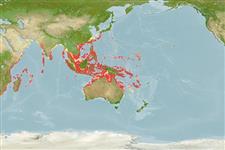Classification / Names
Common names from other countries
Main reference
Size / Weight / Age
Max length : 30.0 cm TL male/unsexed; (Ref. 48635); max. reported age: 11 years (Ref. 45317)
Length at first maturity
Lm 12.2, range 8 - ? cm
Environment
Marine; reef-associated; non-migratory; depth range 1 - 64 m, usually 4 - 30 m (Ref. 90102)
Climate / Range
Tropical, preferred ?; 32°N - 32°S, 29°E - 171°E (Ref. 5222)
Distribution
Indo-West Pacific: Kenya to southern Mozambique eastward to the western Pacific. Reported from the Arafura Sea (Ref. 9819). Not reported from oceanic islands in the Indian Ocean, except for Aldabra, Comoros, Madagascar, and the Andaman and Lakshadweep islands. Unknown from the Red Sea, Persian Gulf, and from the islands of Micronesia except for Palau. Record from Rodriguez by Heemstra & Randall (1984, Ref. 3153) could not be verified and is probably erroneous (Ref. 33390).
Countries | FAO areas | Ecosystems | Occurrences | Introductions
Short description
Dorsal
spines
(total): 9;
Dorsal
soft rays
(total): 15-17;
Anal
spines: 3;
Anal
soft rays: 8. Brownish to greenish grey with dusky vertical bands over the body. White margins and black sub-margins on the median fins (Ref. 48635). Preopercle rounded, very finely serrate; no enlarged spines at angle, lower edge fleshy; characterized further by having ctenoid scales on body including abdomen; greatest depth of body 2.6-3.1 in SL; rounded caudal fin; pelvic fins not usually reaching anus, 1.6-2.1 in head length (Ref. 90102).
IUCN Red List Status (Ref. 115185)
Threat to humans
Harmless
Human uses
Fisheries: subsistence fisheries; aquarium: commercial
More information
ReferencesAquacultureAquaculture profileStrainsGeneticsAllele frequenciesHeritabilityDiseasesProcessingMass conversion
Tools
Special reports
Download XML
Internet sources
Estimates of some properties based on models
Phylogenetic diversity index
PD50 = 0.5000 many relatives (e.g. carps) 0.5 - 2.0 few relatives (e.g. lungfishes)
Trophic Level
4.1 ±0.6 se; Based on diet studies.
Resilience
Medium, minimum population doubling time 1.4 - 4.4 years (tm=1-2)
Vulnerability
Low to moderate vulnerability (31 of 100)
Price category
